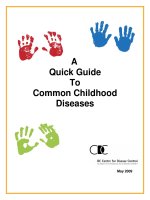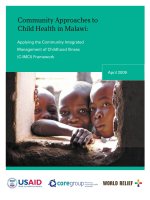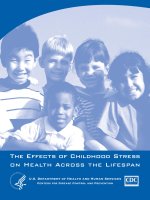5473 childhood
Bạn đang xem bản rút gọn của tài liệu. Xem và tải ngay bản đầy đủ của tài liệu tại đây (58.15 KB, 3 trang )
WEDNESDAY, Feb. 23 (HealthDay News) -- How quickly and smoothly people move on
from a lover's quarrel has a lot to do with the relationships each partner had in earliest
childhood with the people who raised them, new research reveals.
The finding stems from the the University of Minnesota's ongoing tracking of a group of
people that began in the mid-1970s, before the study participants were even born.
Doctoral candidate Jessica E. Salvatore and a team of researchers from the University of
Minnesota report their observations in the current issue of Psychological Science.
The authors explain that when the study participants reached the age of 20, each was asked to
enlist his or her romantic partner in a discussion exercise in which they were first instructed
to launch a topic of conversation about an issue on which there was disagreement.
The resulting quarrel was then followed by a second discussion of a subject on which the
partners saw eye to eye. This discourse was viewed as a "cool-down" period, designed to
transition away from the previous conflict.
However, Salvatore and her co-authors noticed that not all cool-downs transpired with equal
ease. In some cases, the partners were able to quickly leave their fight behind; in others, one
or both partners were unable to let go of the previous conflict.
A subsequent look at each partner's early childhood background (between the ages of 1 and
18 months) unearthed a connection between the quality of their early connection to their
caregivers and their ability to move on from conflict as adults.
Specifically, those who had more so-called "secure" attachments to their childhood caregivers
seemed to have less of a problem dealing with conflict in the present. In other words,
caregivers who had more success regulating the negative emotions of their young wards
instilled them with better coping skills for dealing with negative emotions as adults.
That said, the authors noted that those with saddled with a less-than-idyllic past are not
necessarily doomed to live out a contentious present. Their suggestion: when it comes to
compensating for an emotionally negative childhood, marry up -- emotionally.
"We found that people who were insecurely attached as infants but whose adult romantic
partners recover well from conflict are likely to stay together," Salvatore noted. "If one
person can lead this process of recovering from conflict, it may buffer the other person and
the relationship."
"That, to us, was the most exciting finding," he added. "There's something about the
important people later in our lives that changes the consequences of what happened earlier."
SOURCE: Psychological Science, Feb. 18, 2011, news release
buffer caregivers changes compensating connection cool-down coping dealing do enlist
explain eye have launch leave let live marry move move recover regulating report
reveals stay stems tracking transition
WEDNESDAY, Feb. 23 (HealthDay News) -- How quickly and smoothly people ________
on from a lover's quarrel has a lot to ____ with the relationships each partner had in earliest
childhood with the people who raised them, new research ______________ . The finding
__________ from the the University of Minnesota's ongoing ________________ of a group
of people that began in the mid-1970s, before the study participants were even born. Doctoral
candidate Jessica E. Salvatore and a team of researchers from the University of Minnesota
____________ their observations in the current issue of Psychological Science. The authors
______________ that when the study participants reached the age of 20, each was asked to
____________ his or her romantic partner in a discussion exercise in which they were first
instructed to ____________ a topic of conversation about an issue on which there was
disagreement. The resulting quarrel was then followed by a second discussion of a subject on
which the partners saw ______ to eye. This discourse was viewed as a "
__________________ " period, designed to ____________________ away from the previous
conflict. However, Salvatore and her co-authors noticed that not all cool-downs transpired
with equal ease. In some cases, the partners were able to quickly __________ their fight
behind; in others, one or both partners were unable to ______ go of the previous conflict. A
subsequent look at each partner's early childhood background (between the ages of 1 and 18
months) unearthed a connection between the quality of their early ____________________ to
their caregivers and their ability to ________ on from conflict as adults. Specifically, those
who had more so-called "secure" attachments to their childhood caregivers seemed to
________ less of a problem ______________ with conflict in the present. In other words,
____________________ who had more success ____________________ the negative
emotions of their young wards instilled them with better ____________ skills for dealing with
negative emotions as adults. That said, the authors noted that those with saddled with a lessthan-idyllic past are not necessarily doomed to ________ out a contentious present. Their
suggestion: when it comes to ________________________ for an emotionally negative
childhood, __________ up -- emotionally. "We found that people who were insecurely
attached as infants but whose adult romantic partners ______________ well from conflict are
likely to ________ together," Salvatore noted. "If one person can lead this process of
recovering from conflict, it may ____________ the other person and the relationship." "That,
to us, was the most exciting finding," he added. "There's something about the important
people later in our lives that ______________ the consequences of what happened earlier."
SOURCE: Psychological Science, Feb. 18, 2011, news release









